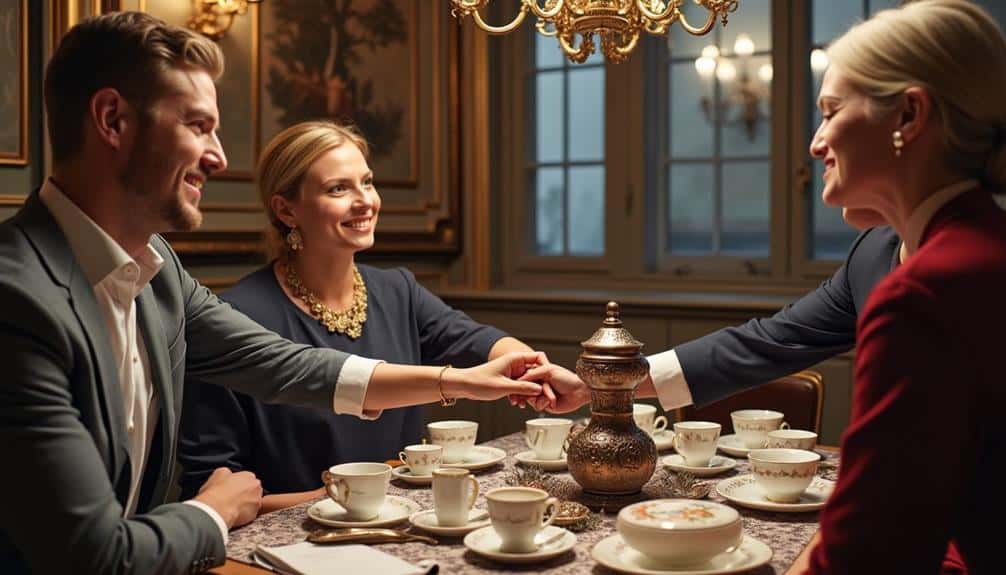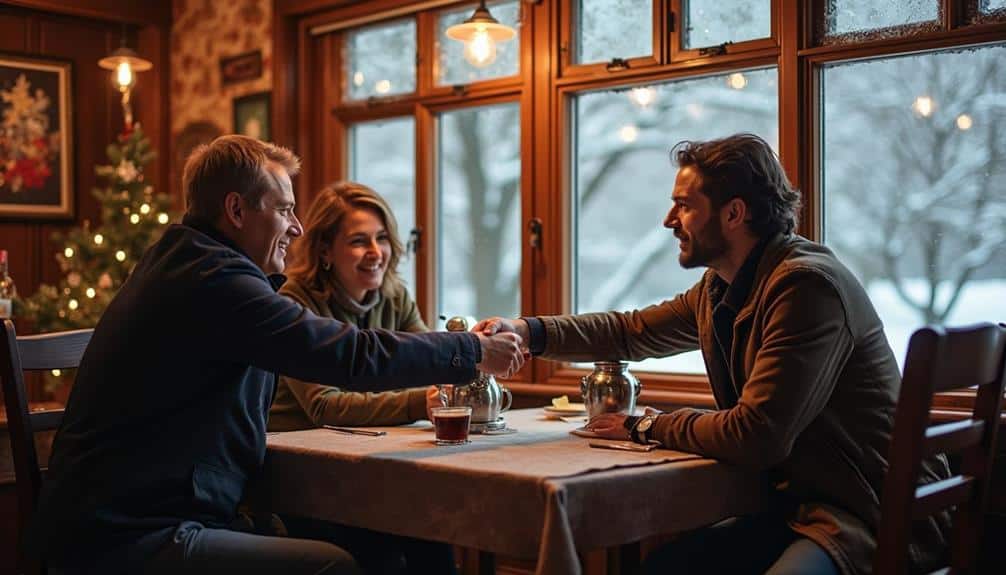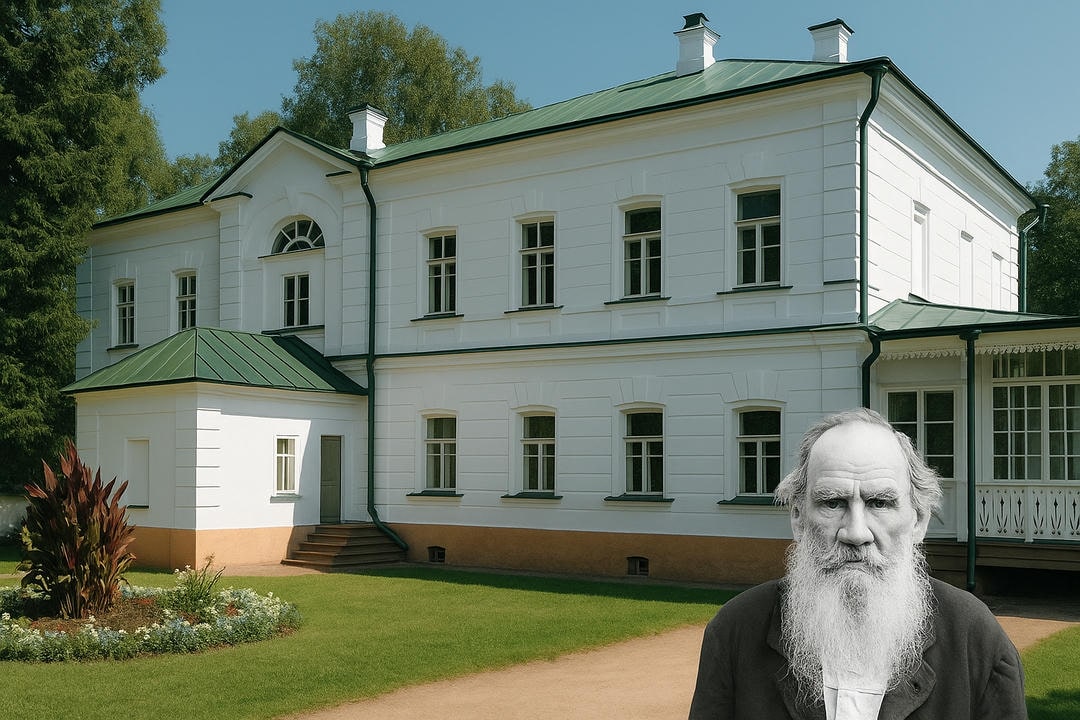Understanding greetings and manners in Russian culture is vital to effective and respectful communication. Formal greetings like “Здравствуйте” (Zdravstvuyte) are used in professional settings and with elders, whereas “Привет” (Privet) is reserved for friends. Respect is central in interactions, emphasizing titles and surnames. Common polite expressions such as “пожалуйста” (please) and “спасибо” (thank you) are essential. Non-verbal cues, including firm handshakes and direct eye contact, play a significant role. Mastering these aspects not only shows cultural awareness but also facilitates smoother interactions. To gain a deeper insight into these practices, further exploration is encouraged.
Understanding Formal and Informal Greetings

Understanding the distinctions between formal and informal greetings in Russian is important for establishing appropriate social interactions.
Formal greetings, such as “Здравствуйте” (Zdravstvuyte), are typically used in professional settings and when addressing elders, reflecting a high level of respect.
In contrast, informal greetings like “Привет” (Privet) are reserved for friends and peers, emphasizing familiarity and ease in communication.
What Are Formal Greetings?
Formal greetings in Russian serve as an essential component of respectful and courteous interactions, particularly in professional or unfamiliar contexts. Understanding the cultural nuances of these greetings can greatly enhance one’s ability to navigate formal occasions effectively.
A quintessential example is “Здравствуйте” (Zdravstvuyte), a term that directly translates to “Hello” but carries a formal tone, making it suitable for business interactions and first-time meetings.
Greeting etiquette in Russia often emphasizes the importance of titles and surnames. For instance, addressing someone by their full name, including patronymic, demonstrates respect and acknowledges their professional or social standing. This practice is particularly prevalent in business interactions where formalities are strictly observed.
Regional variations also play a role in how formal greetings are executed. In some parts of Russia, additional gestures such as a firm handshake or a slight bow may accompany verbal greetings, further reinforcing the respect conveyed.
What Are Informal Greetings?
In contrast to the structured and respectful nature of formal greetings, informal greetings in Russian offer a more relaxed and approachable way to interact, particularly among friends, family, and peers. Casual encounters typically begin with the ubiquitous “Привет” (Privet), which translates to “Hi” or “Hello.” This greeting is largely used in friendly interactions and among individuals of similar age groups, reflecting the cultural nuances of familiarity and camaraderie.
Age differences play an essential role in determining the appropriateness of informal greetings. For instance, younger individuals often use “Привет” among themselves but might opt for more formal salutations when addressing elders.
Another common phrase is “Как дела?” (Kak dela?), meaning “How are you?”—a question that signals genuine interest in the other person’s well-being.
Regional variations also influence informal greetings. In some areas, you might hear “Здорово” (Zdorovo) or “Приветик” (Privetik), adding a layer of local flair to the interaction.
Understanding these nuances can greatly enhance one’s ability to navigate social contexts more effectively.
The Importance of Showing Respect When Greeting Someone
Respect plays an essential role in Russian greetings, serving as a foundational aspect of effective communication and social interaction. The cultural significance of showing respect is deeply embedded in Russian society, where a respect hierarchy influences how individuals address one another.
First impressions are vital, and a well-executed greeting can set a positive tone for future interactions. Understanding the nuances of greeting etiquette can therefore be a substantial asset for anyone engaging with Russian speakers.
In formal settings, greetings such as “Здравствуйте” (Zdravstvuyte) are preferred, reflecting both deference and professionalism. Conversely, informal greetings like “Привет” (Privet) are reserved for close acquaintances and friends.
The distinction between these forms underscores the importance of context and relationship in determining the appropriate level of respect.
Regional variations also play a role in greeting customs, with slight differences observed across Russia’s vast expanse. Awareness of these variations can further enhance one’s ability to make a favorable impression.
Mastery of both formal and informal greetings not only conveys respect but also demonstrates cultural awareness, facilitating smoother and more meaningful interactions in diverse settings.
Common Russian Greetings and Their Usage
Common Russian greetings encompass both basic expressions suitable for any situation and specific phrases tailored to different times of the day.
For instance, “Здравствуйте” (Zdravstvuyte) serves as a universal greeting, while “Доброе утро” (Dobroye utro) is used exclusively for mornings.
Understanding the appropriate context for each greeting aids in fostering respectful and culturally aware interactions.
Basic Greetings for Any Situation
Mastering basic greetings is a foundational step for anyone learning Russian, as it sets the tone for all subsequent interactions. Russian greeting variations are not only linguistically diverse but also carry profound cultural importance. Understanding when and how to use these greetings can enhance one’s communicative competence and foster smoother social interactions.
“Здравствуй” (Zdravstvuy) is a versatile greeting suitable for most situations, reflecting a neutral formality. In contrast, “Привет” (Privet) is more casual, akin to “Hi” in English, and is commonly used among friends and peers. Regional differences play a role in greeting preferences, with some areas preferring more traditional forms. For instance, in rural regions, formal greetings may be more prevalent.
Body language complements verbal greetings in Russian culture. A firm handshake, direct eye contact, and a nod can greatly impact the reception of your greeting.
Additionally, conversation starters such as “Как дела?” (Kak dela? – How are you?) or “Как поживаете?” (Kak pozhivayete? – How are you living?) can further ease social interactions, paving the way for more engaging dialogues.
Greetings for Specific Times of Day
Understanding the appropriate greetings for specific times of day is pivotal for effective communication in Russian. Such greetings are not only a matter of courtesy but also reflect cultural nuances that can enhance social interactions.
Morning greetings, for instance, are typically expressed as “Доброе утро” (Dobroye utro), setting a positive tone for the day ahead. As the day progresses, “Добрый день” (Dobry den) serves as the standard afternoon salutation, embodying a sense of formality and respect.
In the evening, “Добрый вечер” (Dobry vecher) becomes appropriate, encapsulating the day’s winding down while maintaining a formal yet warm demeanor. Evening farewells often extend beyond simple goodbyes, with phrases like “Спокойной ночи” (Spokoynoy nochi), which translates to “Good night,” adding a personal touch.
Additionally, seasonal greetings and holiday wishes play a significant role in Russian communication. For instance, “С Новым годом” (S Novym godom) is a common holiday wish during the New Year celebrations, reflecting both cultural traditions and social etiquette.
Understanding these temporal greetings enriches one’s linguistic repertoire and fosters deeper cultural connections.
Polite Expressions in Russian

Polite expressions form the backbone of courteous interaction in Russian, encompassing essential phrases such as “пожалуйста” (please) and “спасибо” (thank you).
Additionally, understanding how to apologize and excuse oneself using expressions like “извините” (excuse me) and “прости” (sorry) is vital for maintaining respectful communication.
These expressions not only facilitate smoother social interactions but also reflect a speaker’s cultural awareness and sensitivity.
Saying “Please” and “Thank You”
Expressing politeness in Russian, particularly through the words “please” and “thank you,” is essential for respectful communication. Understanding the cultural differences and the nuances of polite requests and gratitude expressions can greatly enhance social etiquette in Russian interactions.
The word for “please” in Russian is “пожалуйста” (pozhaluysta). It is used in various contexts, from requesting assistance to formal interactions, embodying the essence of courteous behavior.
Gratitude expressions, such as “спасибо” (spasibo) for “thank you,” serve as crucial conversational nuances. “Спасибо” is universally appreciated and used across all social strata, reflecting a genuine acknowledgment of kindness or service.
For more formal scenarios, “благодарю вас” (blagodaryu vas) can be employed, aligning with elevated social etiquette.
Incorporating these expressions effectively requires an understanding of when and how to employ them. Polite requests like “Could you please pass the salt?” in Russian would be “Не могли бы вы передать соль, пожалуйста?” (Ne mogli by vy peredat’ sol’, pozhaluysta?).
Mastery of these phrases demonstrates cultural awareness and respect, fostering positive interactions. As learners endeavor for fluency, recognizing these subtleties will not only enhance their linguistic skills but also their cultural competence.
Apologizing and Excusing Yourself
Following the examination of expressions of politeness such as “please” and “thank you,” it is pertinent to address the mechanisms of apologizing and excusing oneself in Russian. The primary apologizing phrases include “извините” (izvinite) for formal situations and “прости” (prosti) for informal contexts. Both expressions play a significant role in maneuvering social interactions, reflecting cultural nuances that prioritize respect and humility.
In formal situations, “извините” can be used to apologize for minor mistakes or to excuse oneself when interrupting a conversation. For instance, when arriving late to a meeting, one might say, “Извините за опоздание” (Izvinite za opozdanie), meaning “Sorry for being late.”
Conversely, in informal contexts, “прости” is more appropriate among friends or family. If one accidentally bumps into someone, they might say, “Прости, я не хотел” (Prosti, ya ne khotel), translating to “Sorry, I didn’t mean to.”
Responding appropriately to apologies is equally significant. Phrases such as “ничего страшного” (nichego strashnogo), meaning “it’s okay,” and “всё в порядке” (vsyo v poryadke), meaning “everything is fine,” can diffuse tension and foster harmonious interactions.
Mastery of these expressions guarantees effective communication and enhances social etiquette in Russian culture.
Non-Verbal Communication in Russian Culture
Non-verbal communication plays a pivotal role in Russian culture, where body language often conveys as much meaning as spoken words.
Understanding common gestures, such as the way a firm handshake signifies respect or how maintaining direct eye contact indicates sincerity, is essential for effective interaction.
Importance of Body Language
Body language plays an essential role in Russian culture, often conveying more than words themselves. Body language cues in Russia carry considerable cultural weight and are integral to understanding social interactions. Non-verbal communication can be subtle yet potent, influencing the perception of sincerity, respect, and engagement.
Personal space in Russia typically tends to be closer than in many Western cultures, reflecting a cultural preference for intimacy in communication. Eye contact, on the other hand, is critical and often seen as a sign of honesty and attentiveness. Averting one’s gaze may be interpreted as evasiveness or disinterest; therefore, making sustained eye contact is a key component of effective interaction.
Gesture variations also hold particular importance. While some gestures may align with Western norms, others possess unique cultural significance, necessitating awareness to avoid miscommunication. For instance, a firm handshake is common and expected, particularly during formal greetings, highlighting respect and confidence.
Understanding these non-verbal cues is essential for those engaging with Russian culture, as they complement spoken language, enriching the communicative experience. Mastery of body language nuances can greatly enhance interpersonal connections and foster a deeper appreciation of Russian social norms.
Common Gestures and Their Meanings
Understanding the role of body language within Russian culture lays the groundwork for comprehending the specific gestures and their meanings that are prevalent in social interactions.
In Russian culture, handshake customs are essential, typically firm and accompanied by direct eye contact, signifying confidence and respect. Unlike in some Western cultures, maintaining personal space is less rigid in Russia; close proximity during conversations indicates trust and familiarity.
Eye contact in Russian interactions is more intense and sustained compared to many other cultures, demonstrating attentiveness and sincerity. Averting one’s gaze might be interpreted as evasiveness or disinterest. However, this intensity should be balanced to avoid discomfort.
Gestures play a significant role in non-verbal communication. A nod, often accompanied by a slight smile, is a common gesture to express agreement or acknowledgment. Conversely, a sideways head shake indicates disagreement.
The cultural variations in gestures meanings are also noteworthy; for instance, the “OK” sign made with the thumb and index finger can be considered offensive.
Understanding these nuances in Russian non-verbal communication not only enhances the effectiveness of interactions but also fosters deeper cultural connections. By mastering these gestures, learners can navigate social environments with increased confidence and cultural competence.
Practicing Greetings and Manners

To effectively practice greetings and manners in Russian, incorporating role-playing scenarios can be highly beneficial for beginners.
These exercises simulate real-life interactions, providing learners with a safe environment to practice and refine their skills.
Additionally, integrating practical tips for everyday use can help reinforce these concepts, ensuring learners feel confident and prepared in various social contexts.
Role-Playing Scenarios
Engaging in role-playing scenarios provides an effective, immersive method for practicing greetings and manners in Russian, allowing learners to contextualize their linguistic knowledge within real-life situations. By simulating everyday situations, such as meeting someone for the first time or initiating casual conversations, learners can explore various greeting variations and conversation starters in a controlled environment.
Role play scenarios offer a practical approach to understanding the nuances of cultural contexts, which are essential for mastering any language. For instance, learners can practice formal greetings like “Здравствуйте” (Hello) when interacting with elders or in professional settings, while using informal greetings such as “Привет” (Hi) among peers.
These scenarios also allow for the incorporation of non-verbal cues, such as handshakes or nods, further enriching the learning experience.
Moreover, these exercises facilitate an in-depth examination of cultural contexts, highlighting the importance of politeness and respect in Russian social norms. By repeatedly engaging in these simulated interactions, learners can internalize appropriate responses, enhancing their confidence and fluency.
This method not only aids in language retention but also prepares learners for real-world communication, bridging the gap between theoretical knowledge and practical application.
Tips for Everyday Practice
Role-playing scenarios equip learners with a foundational understanding that can be further strengthened with daily practice. To solidify these skills, integrating greeting variations and cultural nuances into everyday interactions is imperative. Consistent exposure to the language and its social expectations enhances fluency and confidence.
One effective method is to immerse oneself in authentic Russian environments, either physically or virtually. Engaging with native speakers through language exchange platforms can provide invaluable real-time feedback. Observing and mimicking their use of greetings and polite expressions will add depth to your language practice.
Incorporating Russian media into daily routines also offers substantial benefits. Watching Russian films, TV shows, or even YouTube channels exposes learners to informal and formal interactions, showcasing a wide range of greeting variations and contexts.
Additionally, practicing with friends or fellow learners can simulate real-life social expectations, making the shift to actual conversations smoother.




